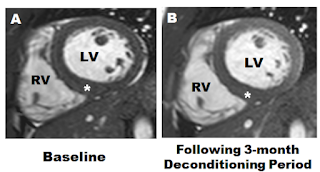Athlete's heart is a condition resulted from intensive endurance or strength training. These training is able to causes functional and structural changes of cardiovascular system. There is an overlap between Athlete's heart and mild forms of hypertrophic cardiomyopathy (HCM). Being able to differentiate between athlete's heart versus HCM is important for management.
LV wall thickness is common value physicians looking for to differentiate those two. Typically, patient with HCM has LV wall thickness > 15mm and one with Athlete's heart has LV wall thickness less than 13 mm. For patient within the 13-15 mm "gray zone", a number of variables should be taken into considerations as listed below:
Cardiac MR with forced detraining of the athlete is a useful strategy to differentiate between athlete's heart and HCM. Patients who decondition over a 3-month period, and in whom wall thickness regresses greater than 2 mm, supports a diagnosis of Athlete's Heart while hypertrophy that remains unchanged suggests HCM.
B. Repeat CMR following 3-month deconditioning showed no change in LV wall thickness. This suggests a diagnosis of HCM.
-YZ-
Reference:
Can too much exercise be dangerous: what can we learn from the athlete’s heart? (bjcardio.co.uk)
Athlete's heart or hypertrophic cardiomyopathy? - PubMed (nih.gov)



No comments:
Post a Comment